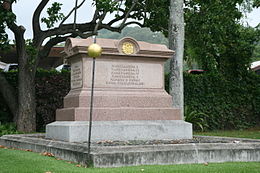- Moses Kekūāiwa
-
Moses Kekūāiwa Prince of Hawaii 
The Kamehameha Tomb at Mauna ʻAla, his name is inscribed on the left side of the monument under "Kekuaiwa". Full name Moses Kekūāiwa Keawenui House House of Kamehameha Father Kekūanāoa Mother Kīnaʻu Born July 20, 1829
Honolulu, OʻahuDied November 24, 1848 (aged 19)
Honolulu, OʻahuBurial Mauna Ala Royal Mausoleum Moses Kekūāiwa Keawenui (July 20, 1829 – November 24, 1848) was a member of the royal family of the Kingdom of Hawaii.
He was the second son of Mataio Kekūanāoa and Elizabeth Kīnaʻu. He was a grandson of Kamehameha I through his mother who was known as Kaʻahumanu II when she was regent. He had three brothers, David Kamehameha (1828–1835), Lot Kapuāiwa (1830–1872), Alexander Liholiho (1834–1863), and a sister Princess Victoria Kamāmalu (1838–1866). He was adopted according to Hawaiian custom (hānai) by High Chief Kaikioʻewa, Governor of Kauai and was heir presumative to the Governor of Kauai.
He was 10 years old when his uncle, King Kamehameha III, placed him in the Chiefs' Children's School, the exclusive school for the children eligible to be rulers. This Royal School was run by Mr. and Mrs. Amos Star Cooke. Under an official order of the king, he was proclaimed eligible to rule the Hawaiian Kingdom. He would have been next in line for the throne if the order of succession were based only on age.
He was not a favorite student of the Cookes.[citation needed] The Cookes and fellow missionaries felt that Hawaiian children were wild and unruly and that the royal children were the worst. Unlike American children, ali'i children were considered to be kapu (sacred) to their subjects. It would be unthinkable for a kahu (servant) to strike a royal charge. The Cookes however, did not hesitate to enforce their rules and would beat the children with a ruler, deprive them of their meal and confining them to their rooms. On one occasion Mr. Cooke struck Alexander on the head and Moses replied, "he keiki a ke ali'i oia nei." Translated as "He is the son of the chief." Cooke replied "I am the King of this school."[1] Many strange and often trying experiences unfolded for both Moses, his classmates and their teachers. In the earliest, most shaping time of their lives, the children had been raised in the environment of their homes which in the 1830s mixed some of the worst features of the old culture and those of the West, newly introduced to Hawaii.
The presence of scrupulously attentive kahus (attendants) within the margin of the school, presented a serious problem to the Cookes. Servants appearing at windows and doors, waiting to indulge the every impulse of their royal charges, continually hampered the educational program. In time this problem was handled, with the dismissing of most of them and replacing them with one, John Papa ʻIʻi. But others troubles developed. Fear of ghosts brought difficulties at nightfall. The children looked everywhere for signs portending trouble with the spirit world. Odd holes in the ground or a particular pattern of shadows on the floor, or some other manifestation, were looked upon as warning signs of demons. [2]
When the permanent school building was completed, the children were housed in rooms of their own but under the same roof with the Cooke family. A strict rule that kahus were not to sleep in the same rooms as the children was enforced upon by their teachers. Before long the rule was broken. Even disciplinary measures, when taken, could not put an end to the weeping that continued into the small hours of the morning. In time the burgeoning sexual urges of the older children presented the necessity of cautious surveillance after dark. The robust tendency of Moses became a great strain on Mr. Cooke's New England-endowed sense of sexual morality. Mathematics, history, philosophy, and music were embellished with interpolations of long-established lore superimposed upon the Western curriculum by fervent kahus and the older generation at home. In time the question of their future activities, including marriage, became a paramount issue.[2] He was among the first to graduate from Royal School, although he actually left on his own accord.
Moses, the eldest male of his generation and a lineal descendant of Kamehameha I, was expected to marry a high chiefess of rank to continue the royal line. He was engaged to the Tahitian Princess Ninito Teraʻiapo, who set sail for Hawaii, but arrived to the news of his death. He died November 24, 1848 at Honolulu in a measle epidemic. He was 19-years old, unmarried, and without any children.[3]
See also
- Hawaii – Tahiti relations
References
- ^ Kanahele, George S.. Emma: Hawai'i's Remarkable Queen : a Biography . University of Hawaii Press, 1999.
- ^ a b http://www.janesoceania.com/hawaii_monarchy/index.htm
- ^ http://digital.library.upenn.edu/women/liliuokalani/hawaii/hawaii.html#II
Categories:- 1829 births
- 1848 deaths
- Royal Family of Hawaii
- Princes of Hawaii
- House of Kamehameha
- Infectious disease deaths in Hawaii
- Burials in the Kamehameha Tomb (Royal Mausoleum of Hawaii)
- Hawaiian adoptees (hānai)
Wikimedia Foundation. 2010.
